Iroquois Theatre Fire (1903)
Introduction
Text-to-speech Audio
Images
The Iroquois Theater
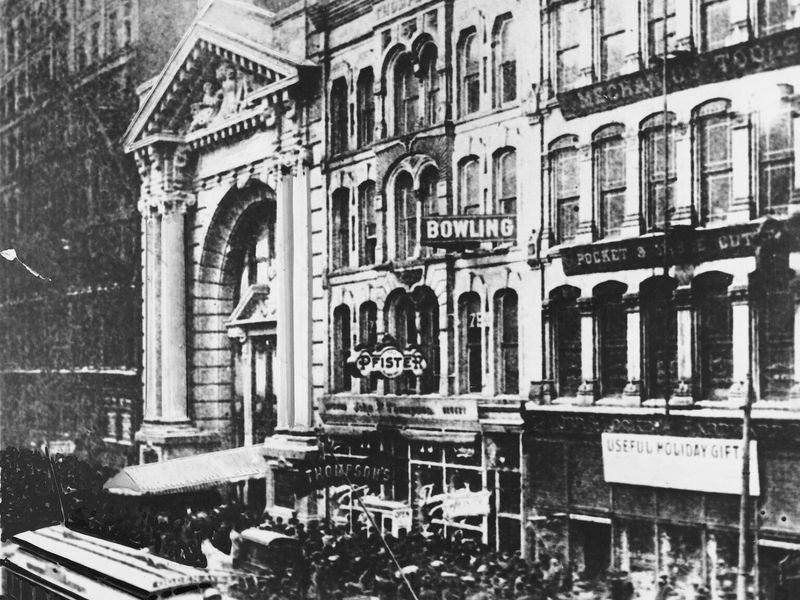
The lamp believed to have started the fire. A spark from the lamp ignited nearby drapery.
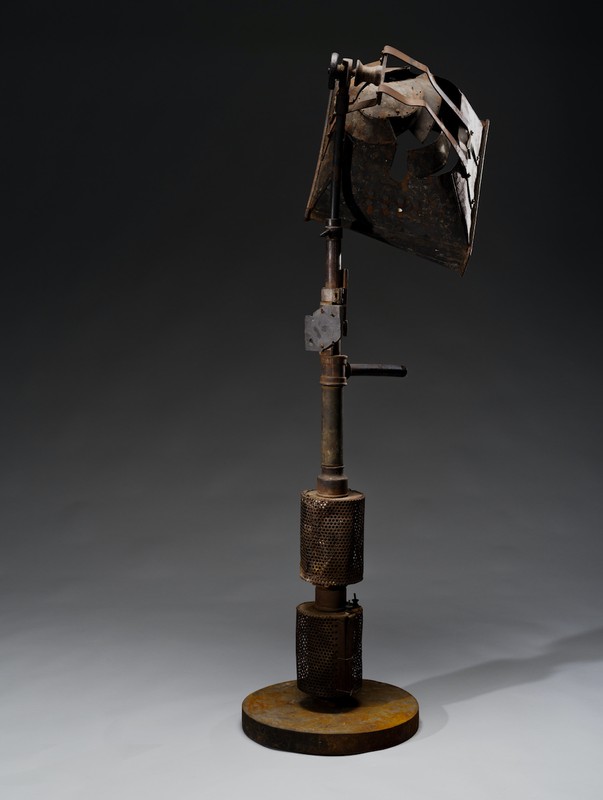
A playbill from the performance that day, singed by the fire. Notice that the theater is advertized as "absolutely fireproof" in the upper right corner.
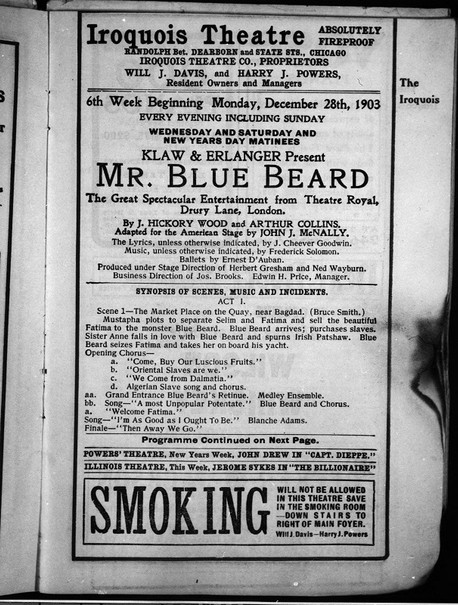
View looking down on the stage from the balcony after the fire
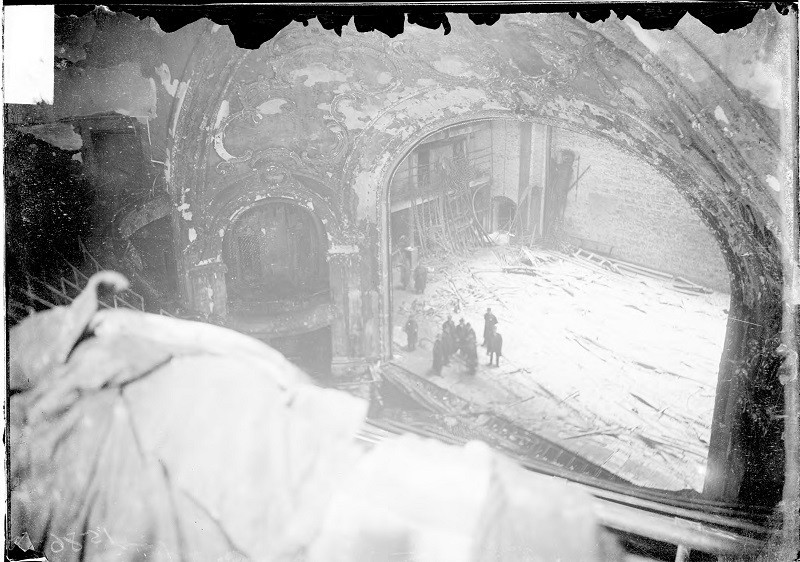
Accordian gates across the stairways to prevent patrons from sneaking down to more expensive seats proved to be fatal during the fire. Most of the loss of the life occured at these locked gates and exits.
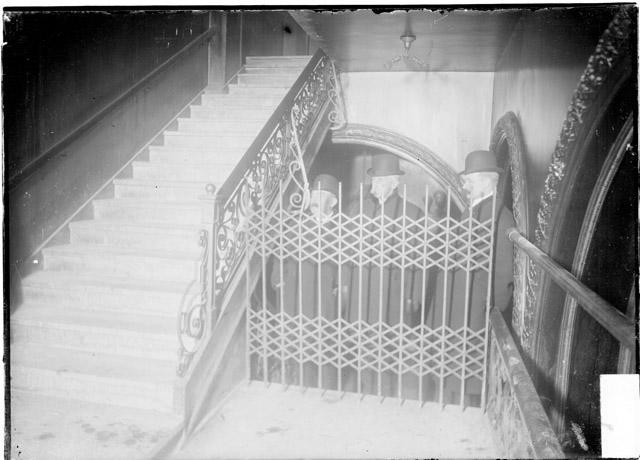
Backstory and Context
Text-to-speech Audio
The “Absolutely Fireproof” Theater
The Iroquois Theatre opened in Chicago’s Theater District on November 27, 1903. The theater was designed in an opulent Renaissance style. Construction on the building was rushed so that theater could be open in time for the profitable holiday season. Nevertheless, Chicago’s building commissioner and fire inspector dubbed the theater “fireproof beyond all doubt.” [1] However, a less-publicized report from the editor of Fireproof Magazine was scathing, pointing out that the building lacked an intake draft shaft, had too much exposed wood trim, and had inadequate exits. In addition, an inspection by the captain of Engine Company 13 warned about the theater’s lack of fire extinguishing equipment and the fact that there was no fire alarm or sprinkler system, but the captain was overruled by his superiors. It is suspected that authorities may have been paid off to turn a blind eye to the theater’s code violations; such corruption was common in the city at the time.
The Fire
The matinee performance of Mr. Bluebeard began at the theater in the afternoon of Wednesday, December 30, 1903. The show was a musical comedy based on a children’s fairytale, attended mostly by women and children who were on their holiday break. Eddie Foy was the show’s lead and drew huge crowds to the show as a wildly popular comedian and native of Chicago. The theater’s seating capacity was about 1600, but attendance was estimated to be closer to 1800, with standing ticket holders taking up space in the aisles. In addition, there were almost 400 actors and stagehands working backstage.
In the second act of the performance, around 3:15pm, a spark from a faulty stage light set fire to some nearby drapery. Staff attempted to use an extinguisher on it and to also lower a flame-retardant asbestos curtain, neither of which worked. The fire quickly spread through the painted backdrops, and performers ran off the stage to escape it, as the audience became aware of what was happening. Eddie Foy came on stage and attempted to calm the audience and direct them to the exits. However, many of the exit doors were blocked by curtains. In addition, the doors and several accordion-style gates in the balcony had been locked to deter people from sneaking to more desirable seats without paying.
Backstage staff fled out the door behind the stage. The sudden backdraft fanned the flames, and a fireball launched into the audience, instantly killing dozens. Some people found themselves trapped at an upper-level fire escape that had no ladder to safety. Wooden planks were laid down as a makeshift bridge to the building across the alley, but some who attempted to cross it fell to their deaths. Bodies began to pile up inside, some crushed in a stampede at the blocked exits. It has been estimated that most of the 603 people that died in the fire were lost within fifteen minutes of it starting, before firefighters even arrived. A diner next door to the theater became a makeshift morgue, and as relatives arrived to search for their loved ones, the city fell into a state of shock and grief.
Aftermath and Changes
Investigations into the fire went on for years afterwards. Although city officials, the owner, and even the architect were all summoned to court proceedings, none of them would be held liable in the end. As Francine Uenuma of Smithsonian Magazine has pointed out: “The myriad problems that day turned into an algebra of blame—so many had failed to carry out their duties that no one source could be concretely assigned sole responsibility. […] In the end, a batch of payouts to families from the construction company that had built the theater was the only concrete liability.” [3]
As frustrating as the outcome of the investigations were, the tragedy is credited with a renewed vigilance in building code safety and awareness of fire hazards. In the weeks after the fire, theaters across Chicago and across the nation were shut down in order to check them for fire code compliance. Chicago city officials passed new building ordinances within a matter of weeks. Some of the new standards included lighted aisles, marked exits, effective fire extinguishers, fire alarm and sprinkler systems, occupancy limitations, and installation of rooftop flues. The Iroquois Theater fire is also cited as the inspiration for “panic bars” on doors, which keep the doors locked on the outside but allow people inside to quickly exit using easy bar release handles.
A memorial plaque to victims of the Iroquois Theatre fire is located in Chicago’s City Hall near its LaSalle Street entrance. A memorial sculpture was erected in Montrose Cemetery, where many of the victims are buried. The Iroquois Theatere reopened under new ownership less than a year after the fire as the Colonial Theatere. It was torn down in 1926 and replaced by the Oriental Theatre, now Nederlander Theatre.
Sources
1. History.com Editors. “This Day in History: 1903, December 30, Fire breaks out in Chicago theater.” History.com, A&E Television Networks. November 13, 2009. Accessed January 13, 2020. https://www.history.com/this-day-in-history/fire-breaks-out-in-chicago-theater.
2. Hatch, Anthony P. Tinder Box: The Iroquois Theater Disaster 1903. Chicago Review Press, Feb 1, 2003. Accessed January 13, 2020. https://books.google.com/books?id=5mdQCgAAQBAJ&source=gbs_navlinks_s.
3. Uenuma, Francine. “The Iroquois Theater Disaster Killed Hundreds and Changed Fire Safety Forever.” Smithsonian Magazine Online. June 12, 2018. Accessed January 13, 2020. https://www.smithsonianmag.com/history/how-theater-blaze-killed-hundreds-forever-changed-way-we-approach-fire-safety-180969315/.
4. Cox, Ted. “Iroquois Theater Fire Almost Forgotten, But Continues To Haunt.” DNAinfo News. December 30, 2013. Accessed January 13, 2020. https://www.dnainfo.com/chicago/20131230/loop/iroquois-theater-fire-almost-forgotten-but-continues-haunt/.
5. Dorhauer, Jeff. “The origins of the ‘Panic Bar’”. Lake News Online. October 12, 2016. Accessed January 13, 2020. https://www.lakenewsonline.com/opinion/20161012/origins-of-panic-bar.
Chicago History Museum/Smithsonian Magazine: https://www.smithsonianmag.com/history/how-theater-blaze-killed-hundreds-forever-changed-way-we-approach-fire-safety-180969315/
Chicago History Museum/Smithsonian Magazine: https://www.smithsonianmag.com/history/how-theater-blaze-killed-hundreds-forever-changed-way-we-approach-fire-safety-180969315/
Chicago History Museum/Northwestern University: https://florencekelley.northwestern.edu/historical/iroquois/
Chicago History Museum/Northwestern University: https://florencekelley.northwestern.edu/historical/iroquois/
Iroquois Theater Blog: http://www.iroquoistheater.com/accordion-gate-iroquois-theater-deathtrap.php
